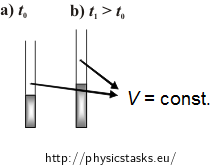Mercury in a Tube
Task number: 1810
A glass tube has a coefficient of volume expansion equal to 28.2·10−6 °C−1, its one end is sealed, its cross-section is the same at each point of the tube and it is 100 cm long at the temperature of 0 °C. Mercury with the coefficient of volume expansion equal to 18·10−5 °C−1 and with temperature of 0 °C is poured into this tube. Mercury reaches so high, that the unfilled space maintains the same volume during temperature changes.
How high is the level of mercury?

Hint
What is happening with the volume of a body when it is being heated and what is the relationship between the volume changes of mercury and the tube, so that the volume of the unfilled space remains constant?
Analysis
When heating the tube with mercury, the volumes of mercury and the tube increase. If we do not want the volume of unfilled space to change, the volume increase of mercury must be equal to the volume increase of the tube.
The unknown height to which mercury is poured is obtained by comparing the two increased volumes, which can be expressed by the relation for thermal volume expansion. Furthermore, we use the fact that the ratio of the height reached by mercury and the height of the tube is due to constant cross-section equal to the ratio of their volumes.
Given values
l0 = 100 cm initial length of the tube l1 = ? height to which the mercury needs to be poured From The Handbook of Chemistry and Physics:
β1 = 18·10−5 °C−1 coefficient of volume expansion of mercury β2 = 28.2·10−6 °C−1 coefficient of volume expansion of glass Solution
We denote V1 the volume of mercury at initial temperature and V2 the volume of the whole tube. When the temperature increases by Δt, the volume of mercury increases by a value of ΔV1, for which, according to the basic formula for volume expansion, it holds
\[\mathrm{\Delta} V_{1}=V_{1} \beta_{1}\mathrm{\Delta} t\,,\]where β1 is the coefficient of volume expansion of mercury.
At the same time, however, the volume of the tube increases with increasing temperature. For this increase it applies.
\[\mathrm{\Delta} V_{2}=V_{2} \beta_{2}\mathrm{\Delta} t\,,\]where β2 is the coefficient of volume expansion of glass.
Provided that the volume of the unfilled part of the tube is not temperature dependent, the change on volume ΔV1 of mercury must necessarily be the same as the change in volume ΔV2 of the whole tube.
Using this fact, we write
\[\mathrm{\Delta} V_{1}=\mathrm{\Delta} V_{2}\,.\]We substitute from the equations above:
\[V_{1} \beta_{1}\mathrm{\Delta} t=V_{2} \beta_{2}\mathrm{\Delta} t\,.\]We adjust this equation:
\[\frac{V_{1}}{V_{2}}=\frac{\beta_{2}}{\beta_{1}}\,.\]The ratio of the length of mercury column l1 and the length of the whole tube l2 is due to the same cross-section the same as the ratio of the respective volumes. For this reason the length of the mercury column can be written as
\[\frac{l_{1}}{l_{2}}=\frac{V_{1}}{V_{2}}.\]From here we obtain:
\[l_{1}=l_{2}\frac{V_{1}}{V_{2}}=l_{2}\frac{\beta_{2}}{\beta_{1}}\,.\]Numerical solution
\[l_{1}=l_{2}\frac{\beta_{2}}{\beta_{1}}=100\cdot \frac{28.2\cdot{10^{-6}}}{18\cdot{10^{-5}}}\,\mathrm{cm} \dot{=}16\,\mathrm{cm}\]Answer
Mercury was poured to a height of approximately 16 cm.



